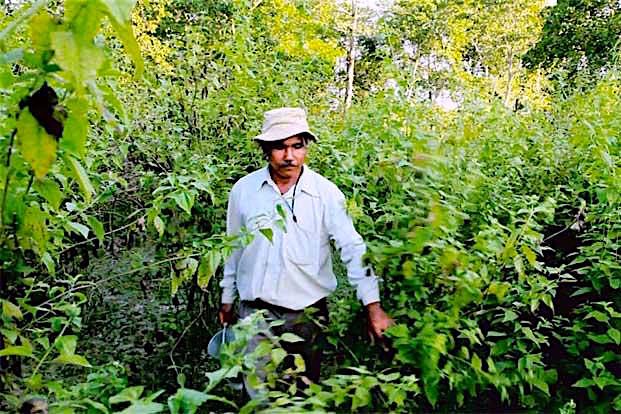
A film, Forest Man, by Canadian film-maker Will McMaster chronicles the Forest Man’s ongoing efforts to nurture and expand the forest he created on a Brahmaputra sandbar.
Early morning, on the day before Bihu, the Assamese new year, Jadav Molai Payeng picked up his mobile phone at half a ring. He said he was about to board the canoe that takes him to his forest every day, but that he would wait and sit down to talk. “The only people who really love me and my forest is reporters,” he said, in a thick Upper Assam accent. He talks so briskly he almost chews words.
In 2009, Jitu Kalita, a wildlife reporter and columnist from Jorhat who writes for the general interest magazine Prantik, discovered Payeng and his forest and took them places. For around 20 years until then, Payeng had lived in a hut in a village named Arunasapori, deserted in an expansive sandbar of the Brahmaputra in Majuli in Jorhat district. Majuli is the world’s largest river island.

Since 2009, he has travelled to Guwahati, Mumbai and France. The state has felicitated him with titles and rewards, non-governmental organizations have announced associations with him, but Payeng says nobody really assists him in the work. He sounds somewhat relieved by that, because he is a man obsessed with his forest.
Payeng’s story is not just about wildlife conservation. It is a romance, and a fable. It is about human fire and the possibilities that human effort can unravel.
“I work every day, growing, tending, cleaning. In the branches of big trees, I am growing orchids now. Every year, the floods destroy some of the forest, and I have to grow some more,” Payeng says. He has now started planting seeds in another adjacent village, Mekahi. Payeng recently travelled to nearby Kaliabor, where he is a registered voter, to vote for a change in government. “I still don’t have a ration card,” he says. Payeng and his family own buffaloes and cows, and earn their livelihood by selling milk. They ferry it every morning from their bamboo hut on stilts to the edge of the nearby riverbank, to the milk sellers of Majuli.

His story has now been made into a film, Forest Man, by Canadian film-maker Will McMaster and the film production house Polygon Window Productions. After receiving accolades at film festivals in the US and Europe, it will be releasing soon on YouTube. McMaster and his team, who make films using new virtual reality technologies like the Oculus Rift, spent a month with Payeng and his family—wife Binita, daughter Munmuni and sons Sanjay and Sanjiv—two years ago after McMaster read about him on a website.
McMaster recalls: “When I first laid eyes on the forest, I thought the whole thing was a hoax because I could not believe that someone could have planted so much. But as Payeng took us deeper into the forest, I noticed that a lot of the larger trees were planted in evenly spaced rows that only a human could have done. When I had that realization, all I could do was look at the forest in wonder.”
The film follows the spry and wiry Payeng going about his business. At daybreak, with a cloth-wrapped lunch box, he takes the canoe and sails to his forest. With a sparse narrative voice-over by Kalita, we see Payeng leading the men with the camera from an open vista of water and sand into green envelopes that get progressively impenetrable. He uses seeds plucked from existing trees or transported by wind to plant more of the same variety. In the past two years, he has invested in buying seeds from outside (Jorhat also has the Assam Agricultural University, which supports research on innovation in farming technology), like two varieties of orchids which he mindfully ties to branches. “I will never stop, that is the only way Majuli will survive,” he says. After travelling far, Payeng has become aware of the term “global warming” and uses it generously to describe what he helps counter.
In 2012, a herd of elephants entered his forest and destroyed crops in the neighbouring villages. Livid villagers burnt peripheries of Arunasapori and threatened him. “That was the most joyous day of my life, when animals came to the forest. It was what I wanted to happen since I was 15 or 16. I had seen some snakes washed up here by a big flood, and which slowly died under the sunlight when the waters receded. It was very grim,” Payeng says. Now, rhinos, elephants, even stray tigers inhabit Molai Kathoni during the dry months.
In 2012, at the peak of another devastating flood that almost annihilated Payeng’s forest, villagers heard gunshots. Payeng called for help from the state forest department, but it did not arrive on time. A day later, Payeng found a dead rhino without its horn, its head covered in dried blood. “That is why I have been suspicious of everybody who enters Arunasapori,” he says.
How does a 55-year-old man sustain a forest alone? Who owns this beautiful land that has become, by default, one man’s canvas? What are the perils of a man-made forest?
As it happens, Payeng was a foot soldier for a state reforestation project, to prevent soil erosion in Majuli, in 1979. He was 20. Over the years, many such initiatives, by the forest department and the Brahmaputra Board under the Union ministry of water resources, have died halfway. When that project halted, he approached the local forest officials and asked how he could start growing plants there himself. One of them suggested growing bamboo.
That’s how it started, with a bamboo sapling, in 1979. Now Molai Kathoni has around 100 species of plants, grasses and ferns, some of them medicinal.
Payeng’s ancestral home in Arunasapori was washed away in the 1960s. He is from the Mising tribe, earlier known as the Miris, the second largest ethnic tribe in Assam after the Bodos. His family moved away from the river and settled in another village. He went to work with a family in Baligaon, a neighbouring hamlet, until he was around 15, completing his high school education from a state-run school. He went to Patna, Nepal and Kolkata to look for work, but every two years he would return to the place his family had left. With the reforestation job, he stayed on. He built a hut, and started planting trees.
In 2009, while chasing a story around Majuli, Kalita heard of a mythical forest 20km from where he was. “I reached there by a local boat and started walking. When Payeng saw me, he asked me to leave. He almost chased me out of there.”
Kalita returned a few days later, and then a month later. Binita Payeng invited him to their hut. “She seemed to believe that I could do something for them. Their children were walking 12-15km to go to the nearest school, they had very little money.” Kalita wrote about them in a local daily and three years later, then president A.P.J. Abdul Kalamfelicitated Payeng in New Delhi.
The family now lives in a house closer to the mainland, which, Payeng says, has made his life more difficult because he has to wake up earlier to reach his forest by sunrise. This year, Payeng’s daughter Munmuni completed her high school and he says he has decided to send her to college.
Kalita says: “Molai is a kind of a local hero, but I think nobody in the state takes his work seriously yet. He is like a colourful, mythical person who built a forest. Teachers take schoolchildren to see the forest, film-makers come from faraway countries, but nobody has seriously taken stock of what he is doing—to know where will this forest go and who will take responsibility for it.”
Arup Kumar Sarma, a professor at the Indian Institute of Technology, Guwahati, and an expert on hydraulics and soil erosion caused by the Brahmaputra, has been one of Payeng’s unequivocal supporters. Prof. Sarma says in McMaster’s film that what Payeng is doing is simple reforestation, and if this kind of initiative can cover the entire Brahmaputra basin, Assam will have an economically viable solution to the problem of soil erosion.
Every other year the Brahmaputra ensures bits of Majuli collapse into the mighty water. Environmentalists say the island will submerge in 15 years. Payeng says, with a gung-ho finality, “I need 10 years to save Majuli.”
A second film, The Forest Man of India, about Jadav Payeng is below.
Another film, One Day in ‘Forest Man of India’ Jadav Paying’s Forest is here.
Other articles you ca read about Jadav Paying:
Since the 1970s a Man Has Been Planting a Forest Larger than Central Park, One Tree at a Time
Indian man single-handedly plants a 1,360-acre forest
The Strange Obsession Of Jadav Payeng
Disclaimer: We at Prepare for Change (PFC) bring you information that is not offered by the mainstream news, and therefore may seem controversial. The opinions, views, statements, and/or information we present are not necessarily promoted, endorsed, espoused, or agreed to by Prepare for Change, its leadership Council, members, those who work with PFC, or those who read its content. However, they are hopefully provocative. Please use discernment! Use logical thinking, your own intuition and your own connection with Source, Spirit and Natural Laws to help you determine what is true and what is not. By sharing information and seeding dialogue, it is our goal to raise consciousness and awareness of higher truths to free us from enslavement of the matrix in this material realm.
 EN
EN FR
FR


























To know your great purpose and fulfill it is a form of ascension
Well said, joelinchina, I say Amen to that!
Thank you, Dane Arr, for posting this. I love those initiatives and I’ve worked in such a project in Cornwall UK in 2013. Isn’t it inspiring to see what one man can create on his own, with nature as his best friend? It’s a green breath of fresh air, much welcomed here by me, amidst the mind-boggling updates and rapids of change.